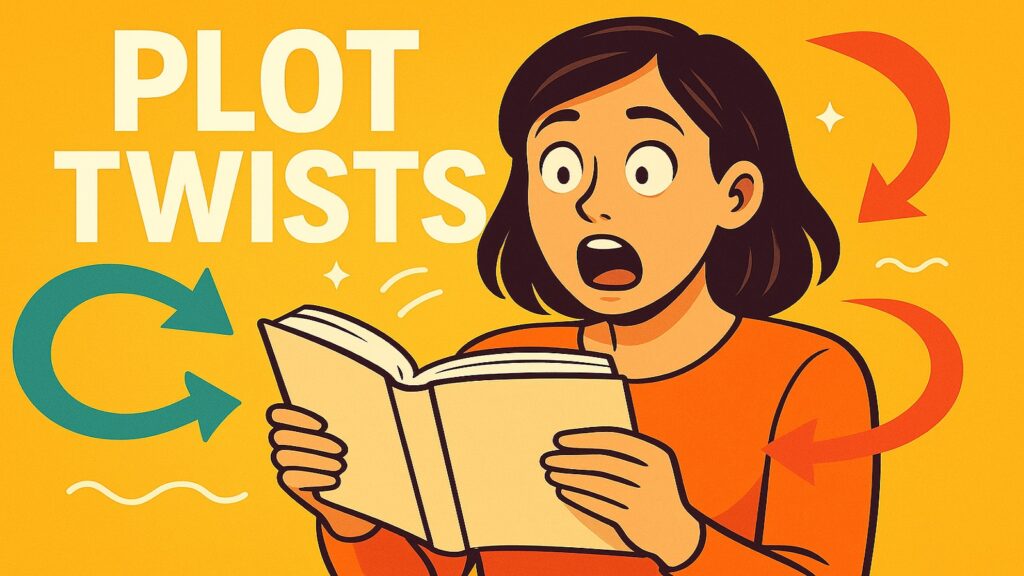Table of Contents
Introduction: Why Plot Twists Reshape Storytelling Psychology
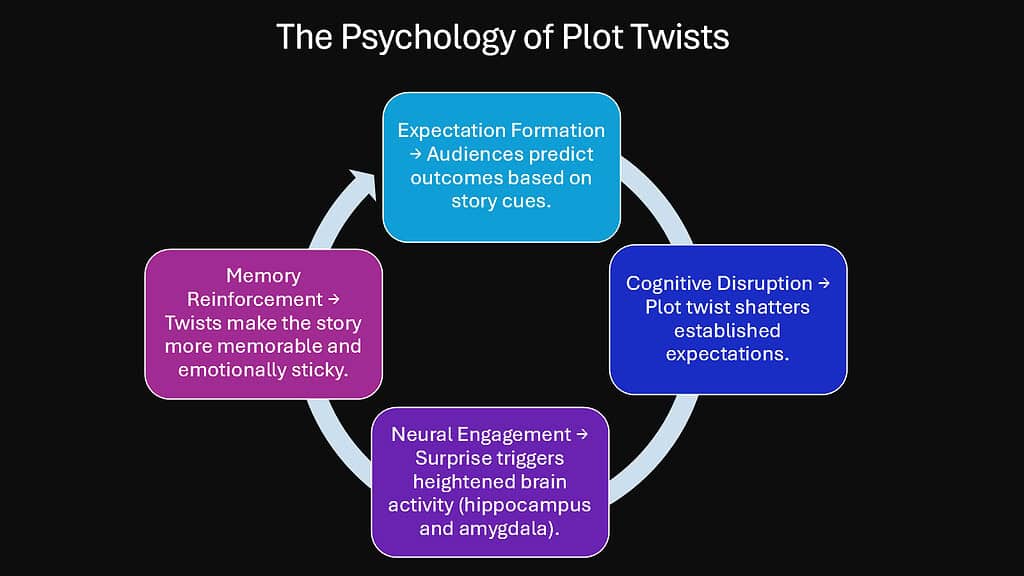
The moment when everything we believed about a story shatters feels like lightning in our minds. Plot twists represent one of storytelling’s most sophisticated psychological tools, transforming passive readers into active participants who must reconstruct their understanding of events. These narrative reversals do more than surprise audiences—they fundamentally alter how we process information and form emotional connections with characters and themes.
Throughout human history, storytellers have understood that the most memorable tales contain moments of revelation that challenge our assumptions. From ancient Greek tragedies to modern streaming series, plot twists serve as psychological catalysts that force audiences to reconsider everything they thought they knew. This cognitive disruption creates lasting emotional imprints that extend far beyond the final page or closing credits.
The psychology behind effective plot twists involves complex interactions between expectation, memory, and emotional processing. When a skilled writer plants seeds of misdirection while maintaining narrative honesty, they create what researchers call “retrospective coherence”—the satisfying realization that all the clues were present but hidden in plain sight. This phenomenon explains why audiences often return to stories immediately after experiencing a major twist, seeking to trace the careful breadcrumbs the author left behind.
Understanding plot twists requires examining their relationship with other storytelling techniques that shape audience psychology. Each narrative tool serves distinct functions in creating memorable experiences, and plot twists occupy a unique position as transformative moments that can redefine entire narratives in seconds.
The six approaches explored in this analysis demonstrate how plot twists elevate storytelling across different dimensions—from classical literary theory to modern digital media. These techniques reveal why certain stories endure while others fade from memory, and how contemporary creators continue to find fresh ways to surprise and engage audiences in an era of information abundance.
Comparison of Plot Twists with Other Storytelling Psychologies
| Storytelling Psychologies | Primary Function | Audience Impact | Timing Strategy | Memory Effect |
|---|---|---|---|---|
| Plot Twists | Cognitive reversal and reframing | Shock, reconceptualization | Strategic revelation points | Creates retrospective coherence |
| Narrative Hook | Initial engagement and curiosity | Immediate attention capture | Story opening | Establishes investment |
| Emotional Arc | Character growth and audience connection | Sustained empathy and investment | Gradual development | Builds emotional attachment |
| Mirror Effects | Self-reflection and identification | Personal resonance and insight | Throughout narrative | Promotes self-examination |
| Suspense | Tension and anticipation | Anxiety and engagement | Prolonged uncertainty | Maintains attention |
| Worldbuilding | Immersion and context | Environmental believability | Gradual revelation | Creates narrative foundation |
| Subtext | Layered meaning and depth | Intellectual engagement | Implicit throughout | Rewards careful analysis |
| Moral Framing | Ethical guidance and reflection | Value consideration | Embedded in conflicts | Influences worldview |
1. Plot Twists as Catalysts of Transformation
Aristotle’s concept of peripeteia, or reversal of fortune, provides the foundational understanding of how plot twists function as transformative forces in storytelling. In his Poetics, Aristotle described peripeteia as the moment when a character’s situation suddenly changes from one state to its opposite, creating a profound shift in both character and audience understanding. This classical framework reveals why effective plot twists feel inevitable in retrospect while remaining surprising in the moment.
The psychological power of peripeteia lies in its ability to create what modern cognitive scientists call “schema disruption.” When audiences build mental models of how a story should unfold, a well-crafted twist forces them to abandon their existing framework and construct a new one. This cognitive restructuring process creates intense emotional engagement because the human brain must work actively to reconcile new information with previously established patterns.
Modern examples of peripeteia demonstrate how this ancient principle continues to drive compelling narratives. In films like The Sixth Sense, the revelation that the protagonist has been dead throughout the entire story forces viewers to reframe every previous interaction. The twist works because it transforms apparent plot holes into meaningful clues, creating the satisfying “aha” moment that Aristotle identified as essential to effective reversal.
The timing of peripeteia requires careful consideration of audience psychology and narrative pacing. Aristotle emphasized that effective reversals should feel both surprising and inevitable—surprising because they challenge expectations, and inevitable because they align with the story’s deeper logic. This balance prevents twists from feeling arbitrary or manipulative, instead creating what he called “proper” plot construction.
Contemporary neuroscience research supports Aristotle’s insights about reversal psychology. Studies show that unexpected narrative developments trigger increased activity in the brain’s anterior cingulate cortex, the region associated with conflict monitoring and cognitive control. This neural response explains why plot twists create such memorable experiences—they literally change how our brains process the story information.
Aristotelian Peripeteia Elements in Modern Plot Twists
| Story Element | Traditional Tragedy | Modern Application | Psychological Function | Audience Response |
|---|---|---|---|---|
| Recognition Scene | Hero discovers true identity | Character realizes hidden truth | Schema reconstruction | Retrospective understanding |
| Fortune Reversal | Fall from high to low status | Situation completely changes | Cognitive reframing | Emotional recalibration |
| Inevitability Factor | Fate and divine will | Logical story consequences | Pattern recognition | Satisfying resolution |
| Emotional Catharsis | Pity and fear release | Complex emotional processing | Psychological relief | Deeper engagement |
| Character Growth | Tragic hero’s quest | Protagonist transformation | Identity development | Empathetic connection |
2. Plot Twists Unlocking Emotional Depth in Storytelling
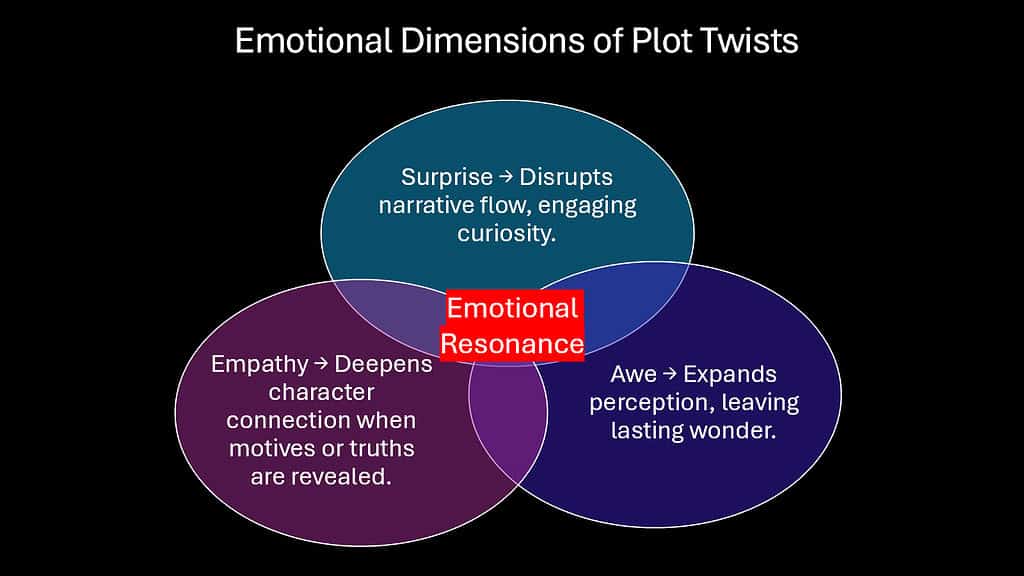
The emotional architecture of plot twists operates through a sophisticated interplay of surprise, empathy, and psychological investment that transforms casual readers into deeply engaged participants. When a twist reveals that a beloved character has been deceiving others or that a villain possesses unexpected nobility, it creates complex emotional responses that simple linear narratives cannot achieve. These moments force audiences to confront their own assumptions and biases, generating the kind of self-reflection that creates lasting story impact.
Surprise functions as the initial emotional trigger, but the deeper psychological work happens in the moments following revelation. Research in affective neuroscience shows that unexpected plot developments activate the brain’s reward system, releasing dopamine and creating positive associations with the story experience. However, the most powerful twists go beyond mere surprise to create what psychologists term “emotional reappraisal”—the process of reevaluating our feelings about characters and situations based on new information.
The empathy-building power of plot twists emerges from their ability to reveal hidden motivations and circumstances that recontextualize previous actions. When audiences discover that an antagonist’s cruelty stems from past trauma, or that a character’s apparent cowardice masks deeper courage, they experience expanded emotional understanding. This empathetic expansion creates stronger connections between audiences and stories, explaining why films and books with memorable twists often develop devoted followings.
Effective plot twists also tap into fundamental human psychology regarding trust and betrayal. Stories that reveal trusted characters as deceptive or despised characters as heroic mirror real-life experiences of discovering hidden aspects of people we thought we knew. This psychological authenticity explains why audiences often describe powerful plot twists as feeling “real” despite occurring in fictional contexts.
The timing and presentation of emotional revelations determine their psychological impact. Twists that feel earned through careful character development create positive emotional responses, while those that seem arbitrary or unearned can damage audience investment. The most successful emotional twists plant seeds of complexity early in the narrative, allowing audiences to build nuanced relationships with characters that can withstand and benefit from later revelations.
Emotional Response Patterns to Different Plot Twist Types
| Twist Category | Initial Emotion | Secondary Processing | Long-term Impact | Reader Relationship Change |
|---|---|---|---|---|
| Character Revelation | Shock and betrayal | Empathy development | Deeper understanding | Increased complexity appreciation |
| Hidden Connection | Surprise and curiosity | Pattern recognition | Enhanced appreciation | Greater story investment |
| Moral Reversal | Confusion and questioning | Value reassessment | Ethical reflection | Expanded moral perspective |
| Identity Twist | Disorientation | Cognitive restructuring | Memory reconstruction | Heightened engagement |
| Motivation Reveal | Emotional conflict | Empathetic reframing | Character sympathy | Relationship deepening |
3. Plot Twists and Narrative Structures That Break Patterns
Vladimir Propp’s morphological analysis of folktales provides crucial insights into how plot twists disrupt expected narrative patterns to create memorable storytelling experiences. Propp identified thirty-one distinct functions that appear consistently across traditional stories, from the hero’s departure to the final wedding or reward. Understanding these established patterns helps writers craft twists that subvert audience expectations while maintaining narrative coherence and emotional satisfaction.
The psychological power of pattern disruption lies in the human brain’s natural tendency to predict outcomes based on familiar story structures. When audiences recognize the beginning of a hero’s quest or a romantic comedy setup, they unconsciously anticipate specific narrative beats and character developments. Skilled storytellers exploit these expectations by establishing familiar patterns before introducing twists that redirect the narrative into unexpected territory.
Propp’s framework reveals why certain types of twists feel more satisfying than others. Functions like “the false hero is exposed” or “the hero is pursued” create natural opportunities for revelation that align with deep-seated story expectations. When writers subvert these expected functions—such as revealing that the apparent hero is actually the villain, or that the pursued character deserves their fate—they create cognitive dissonance that forces audiences to reconstruct their understanding of the entire narrative.
Modern examples of Proppian pattern disruption demonstrate how contemporary creators continue to find fresh ways to surprise audiences familiar with traditional story structures. Films like Shrek deliberately invoke classic fairy tale expectations before systematically subverting them, creating humor and emotional depth through the gap between audience expectations and narrative reality. This technique works because it requires active participation from audiences who must recognize both the traditional pattern and its violation.
The digital age has complicated pattern disruption by making audiences more sophisticated about story structures and potential twists. Contemporary creators must work harder to surprise viewers who actively theorize about plot developments on social media platforms. This evolution has led to increasingly complex narrative structures that layer multiple potential twists or create false twists that mask deeper revelations.
Proppian Functions and Their Twist Potential
| Traditional Function | Expected Pattern | Twist Opportunity | Audience Psychology | Narrative Impact |
|---|---|---|---|---|
| Hero’s Departure | Willing journey begins | Forced or deceptive departure | Assumption challenge | Motivation questioning |
| Magical Helper | Beneficial assistance | Helper with hidden agenda | Trust evaluation | Relationship complexity |
| Villain’s Defeat | Clear good triumphs | Villain’s justified position | Moral reconsideration | Ethical complexity |
| Princess Rescue | Damsel needs saving | Princess as true power | Gender role subversion | Social commentary |
| Final Reward | Hero receives prize | Reward reveals corruption | Value questioning | Meaning reexamination |
4. Plot Twists as Engines of Cultural Reframing
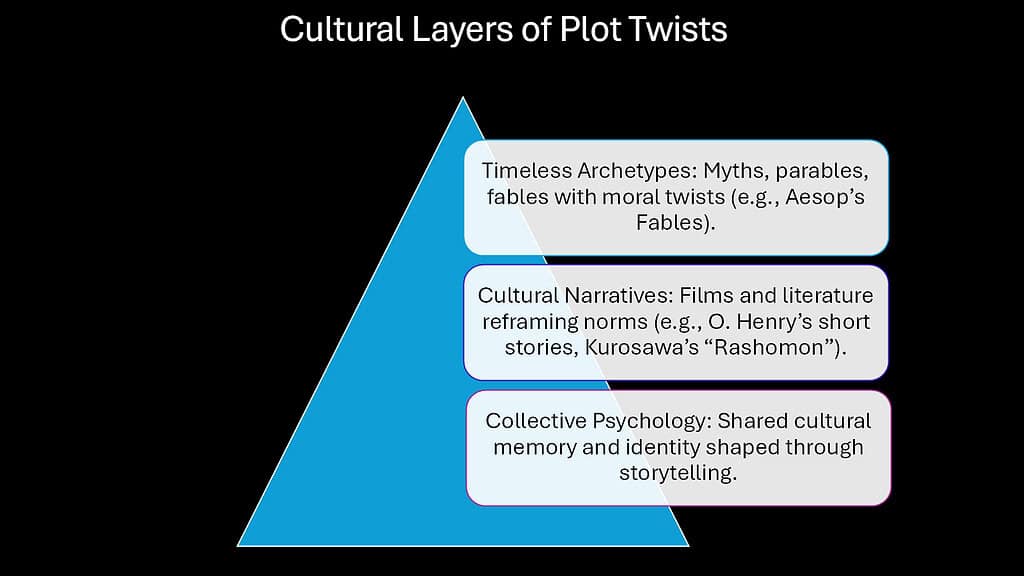
Throughout human history, plot twists have served as powerful vehicles for challenging cultural assumptions and reframing moral understanding within societies. Ancient myths, religious parables, and contemporary narratives use unexpected revelations to guide audiences toward new perspectives on justice, morality, and human nature. These cultural reframing moments often prove more influential than direct preaching because they engage audiences emotionally before delivering their philosophical payload.
The parable tradition demonstrates how plot twists can embed complex moral teachings within seemingly simple narratives. Stories like the Good Samaritan derive their power from the unexpected revelation that help comes from an unlikely source, challenging cultural prejudices about worth and compassion. The plot twists in the narrative force audiences to confront their assumptions about different social groups, creating opportunities for genuine attitude change that direct argumentation rarely achieves.
Modern storytelling continues this tradition of cultural reframing through narratives that reveal hidden truths about contemporary society. Films and novels that expose systemic injustices or challenge dominant cultural narratives often rely on plot twists to make their points more palatable and memorable. The revelation that a respected institution harbors corruption, or that marginalized characters possess greater wisdom than their supposed betters, can shift audience perspectives more effectively than editorial commentary.
The psychological mechanism behind cultural reframing through plot twists involves what researchers call “narrative transportation”—the process by which audiences become so absorbed in stories that they temporarily adopt the worldview presented within them. When these transported audiences experience narrative revelations that challenge their preexisting beliefs, they may internalize new perspectives more readily than they would through direct persuasion attempts.
Cross-cultural analysis reveals that different societies use plot twists to address their specific cultural tensions and moral questions. Japanese literature often features twists that explore themes of honor and shame, while American narratives frequently focus on individual versus collective values. These cultural patterns suggest that plot twists serve as diagnostic tools for understanding societal anxieties and aspirations across different communities.
Cultural Reframing Functions of Plot Twists Across Traditions
| Cultural Context | Common Twist Themes | Social Function | Psychological Impact | Long-term Influence |
|---|---|---|---|---|
| Ancient Mythology | Divine justice reveals | Moral instruction | Behavioral guidance | Value transmission |
| Religious Parables | Unexpected virtue | Spiritual teaching | Belief examination | Faith development |
| Social Justice Narratives | Hidden oppression | Awareness raising | Empathy expansion | Activism inspiration |
| Coming-of-age Stories | Adult world complexity | Maturity guidance | Worldview development | Identity formation |
| Political Allegories | Power structure exposure | Critical thinking | Authority questioning | Civic engagement |
5. Plot Twists Creating Suspense and Reader Engagement
Reader-Response Theory provides essential insights into how plot twists transform passive audiences into active meaning-makers who collaborate with authors in creating narrative significance. Wolfgang Iser’s work on implied readers and gaps in texts reveals how effective twists depend on audience participation in constructing story meaning. Rather than simply delivering information, skilled writers create interpretive spaces that readers must fill, making the eventual twist feel like a collaborative discovery rather than an imposed surprise.
The engagement psychology of plot twists operates through what Louise Rosenblatt termed the “transaction” between reader and text. Audiences bring their own experiences, expectations, and interpretive frameworks to stories, creating unique reading experiences that vary among individuals. Plot twists exploit these personal interpretive processes by presenting information that readers must integrate with their existing understanding, forcing active cognitive work that deepens engagement levels.
Suspense building through strategic information management demonstrates how plot twists can maintain audience attention across extended narratives. Writers create what Alfred Hitchcock called “the bomb under the table”—situations where audiences know something characters do not, or where characters know something audiences do not. The tension between known and unknown information creates psychological investment that keeps readers turning pages or viewers watching screens.
The digital age has transformed reader-response dynamics by enabling real-time audience interaction with stories through social media platforms and fan communities. Contemporary creators must consider how their twists will function not only within individual reading experiences but also within collective meaning-making processes where audiences share theories and interpretations. This evolution has led to more sophisticated narrative strategies that can withstand community scrutiny while still delivering satisfying surprises.
Neuroscientific research supports Reader-Response Theory’s emphasis on active audience participation in meaning construction. Brain imaging studies show that reading fiction activates the same neural regions involved in experiencing real events, suggesting that audiences literally simulate story events in their minds. Plot twists that successfully engage these simulation processes create more vivid and memorable experiences than those that remain purely intellectual exercises.
Reader-Response Elements in The Construction of Plot Twists
| Response Element | Reader Process | Author Strategy | Cognitive Function | Engagement Result |
|---|---|---|---|---|
| Gap Filling | Active interpretation | Strategic omissions | Pattern completion | Collaborative meaning-making |
| Expectation Building | Predictive processing | Foreshadowing placement | Future modeling | Sustained attention |
| Perspective Taking | Empathetic simulation | Character development | Social cognition | Emotional investment |
| Schema Updating | Belief revision | Information revelation | Cognitive flexibility | Learning satisfaction |
| Meaning Construction | Personal relevance | Universal themes | Identity integration | Lasting impact |
6. Plot Twists in Modern Storytelling Across Media
The digital revolution has fundamentally transformed how plot twists function across different media platforms, creating new opportunities for narrative surprise while challenging traditional storytelling assumptions. Streaming services, interactive media, and social networking platforms have created audiences with unprecedented access to story information and community interpretation, forcing creators to develop increasingly sophisticated approaches to maintaining narrative surprise in an interconnected world.
Binge-watching culture has altered the temporal dynamics of the delivery of plot twists, allowing creators to plant and pay off narrative seeds within compressed timeframes while also creating opportunities for more complex, layered revelations across multiple episodes or seasons. Series like Westworld and Dark demonstrate how extended narrative formats can support intricate twist structures that would be impossible within traditional two-hour film constraints, creating viewing experiences that reward both casual consumption and detailed analysis.
Interactive storytelling platforms have introduced entirely new categories of plot twists that respond to audience choices and preferences. Video games and interactive films can deliver personalized revelations based on player decisions, creating unique twist experiences that feel individually crafted. This personalization represents a significant evolution from traditional mass media approaches, where all audiences experience identical narrative revelations regardless of their personal investment or interpretation strategies.
Social media integration has created both challenges and opportunities for plot twist effectiveness. While platforms like Twitter and Reddit make it easier for audiences to share theories and spoilers, they also enable creators to plant false clues and engage directly with fan speculation. Some contemporary creators have learned to use social media discussion as an extension of their storytelling canvas, dropping hints and responding to fan theories in ways that enhance rather than diminish narrative surprise.
The global nature of digital media distribution requires creators to consider how plot twists will function across different cultural contexts and viewing patterns. Techniques that work effectively in American television may not translate to international audiences with different storytelling traditions and cultural expectations. This globalization challenge has led to more universal approaches to plot construction that rely on fundamental human psychology rather than culture-specific narrative conventions.
Modern Media Platform Adaptations for Plot Twists
| Media Platform | Twist Delivery Method | Audience Interaction | Technical Capabilities | Success Factors |
|---|---|---|---|---|
| Streaming Series | Extended narrative arcs | Social media discussion | Binge-viewing patterns | Layered complexity |
| Interactive Media | Choice-responsive reveals | Direct participation | Personalization algorithms | Individual agency |
| Social Platforms | Real-time speculation | Community theory-building | Viral distribution | Collective engagement |
| Gaming Narratives | Player-driven discovery | Interactive consequences | Adaptive storytelling | Personal investment |
| Podcast Fiction | Audio-specific techniques | Listener communities | Intimate delivery | Imaginative participation |
Conclusion: The Enduring Power of Plot Twists in Storytelling
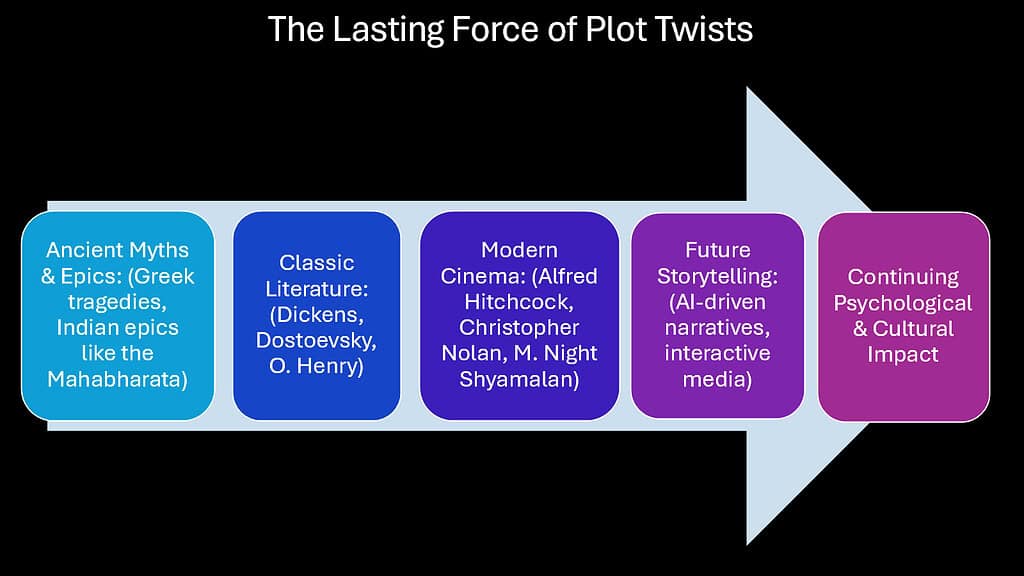
The psychological architecture of plot twists reveals why these narrative devices continue to captivate audiences across cultures, media platforms, and historical periods. From Aristotle’s analysis of peripeteia to contemporary neuroscience research on surprise and memory formation, the evidence consistently points to plot twists as fundamental tools for creating memorable, transformative storytelling experiences that extend far beyond mere entertainment value.
The six approaches examined throughout this analysis demonstrate how plot twists operate simultaneously across multiple psychological and cultural dimensions. They function as catalysts for character transformation, vehicles for emotional deepening, pattern-disrupting surprise mechanisms, engines of cultural reframing, engagement-building collaborative tools, and adaptable techniques for modern media environments. This multifaceted functionality explains why mastery of the construction of the plot twists remains essential for contemporary storytellers working across all narrative formats.
The evolution of plot twist techniques in response to changing media landscapes and audience sophistication suggests that these narrative devices will continue adapting rather than becoming obsolete. As audiences become more knowledgeable about storytelling conventions and more connected through digital platforms, creators must develop increasingly nuanced approaches to surprise and revelation. However, the fundamental human psychology underlying the effectiveness of plot twists — our need for pattern recognition, emotional engagement, and meaning construction—remains constant across technological changes.
The cultural significance of plot twists extends beyond individual entertainment experiences to encompass broader social functions, including moral education, empathy development, and critical thinking enhancement. Stories that successfully challenge assumptions and reframe understanding contribute to societal conversations about justice, identity, and human nature. In an era of increasing polarization and information fragmentation, plot twists that promote cognitive flexibility and perspective-taking may serve important social functions.
Understanding plot twist psychology offers practical benefits for anyone involved in communication, persuasion, or education. The same principles that make narrative revelations memorable and impactful can enhance presentations, marketing campaigns, and educational materials. The key insight from this analysis is that effective surprises require careful preparation, respect for audience intelligence, and alignment with deeper truths rather than mere shock value.
Future Directions for The Development of Plot Twists
| Development Area | Current Trends | Emerging Opportunities | Potential Challenges | Success Requirements |
|---|---|---|---|---|
| Technology Integration | AI-assisted plotting | Personalized narrative paths | Authenticity maintenance | Human creativity balance |
| Cross-cultural Adaptation | Global distribution awareness | Universal psychological appeals | Cultural sensitivity needs | Inclusive storytelling |
| Audience Sophistication | Meta-narrative awareness | Complex layered structures | Surprise difficulty increase | Innovation demands |
| Social Media Integration | Community speculation | Interactive revelation | Spoiler management | Platform coordination |
| Educational Applications | Learning engagement | Cognitive flexibility training | Attention span changes | Pedagogical effectiveness |

